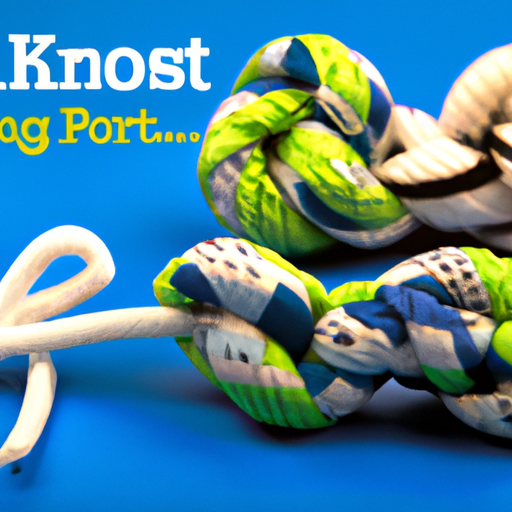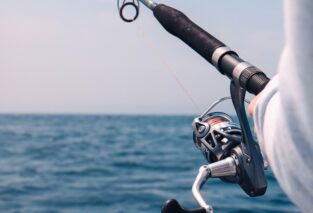In this article, you will discover the ultimate guide to mastering the art of fishing knots with “A Crash Course On Different Types Of Fishing Knots.” Whether you are a beginner angler or an experienced fisherman looking to brush up on your skills, this product offers a comprehensive overview of the various knots used in fishing. From the reliable Clinch Knot to the versatile Palomar Knot, you will learn how to tie each knot step by step, accompanied by detailed illustrations. With this crash course, you will be equipped with the knowledge and techniques needed to secure your fishing line, increase your catch rate, and become a more successful angler.

Basic Knots
Overhand Knot
The overhand knot is the simplest of all fishing knots and is commonly used to stop the line from slipping through a loop or eyelet. To tie the overhand knot, start by forming a loop with the tag end of the line. Then, pass the tag end through the loop and tighten the knot. This knot is easy to tie and untie, making it a versatile option for various fishing applications.
Surgeon’s Knot
The surgeon’s knot is a reliable knot that is often used to join two pieces of fishing line. It is particularly useful for connecting lines of different diameters or materials. To tie the surgeon’s knot, overlap the ends of the two lines and create a loop with both ends. Then, pass the tag end through the loop twice before pulling it tight. This knot provides a strong and secure connection, ensuring that your lines won’t separate during a catch.
Improved Clinch Knot
The improved clinch knot is one of the most widely used knots in fishing as it provides reliable strength and is quick and easy to tie. To tie the improved clinch knot, pass the tag end of the line through the eye of the hook or lure. Then, wrap the tag end around the standing line for five to seven turns. Finally, pass the tag end through the loop formed just above the eyelet and tighten the knot. This knot is known for its strength and resistance to slippage.
Loop Knots
Perfection Loop
The perfection loop is a versatile knot that forms a secure and dependable loop at the end of the line. This loop allows for easy attachment of various fishing tackle, such as lures or flies. To tie the perfection loop, form a loop with the tag end of the line. Then, pass the tag end through the loop twice, ensuring that the second loop is smaller than the first. Moisten the knot and pull both ends to tighten. The perfection loop ensures a strong and flexible connection between your line and the tackle.
Surgeon’s End Loop
The surgeon’s end loop is another useful knot for creating a strong loop at the end of the line. This loop can be used to attach a leader or other terminal tackle. To tie the surgeon’s end loop, create a loop at the end of the line. Then, double the loop back over itself to form a second loop. Hold both loops and pass the tag end through both of them. Moisten the knot and tighten by pulling the standing line and the tag end simultaneously. The surgeon’s end loop provides a secure loop that won’t slip under pressure.

Line-to-Line Knots
Albright Knot
The Albright knot is a reliable knot for joining two lines of different diameters, particularly when connecting a monofilament line to a heavier or thicker line. To tie the Albright knot, overlap the tag end of the heavier line with the tag end of the lighter line. Wrap the lighter line around both ends for 10-15 turns, forming a loop. Then, pass the tag end of the lighter line back through the loop created. Wet the knot and pull on the standing line and the tag end simultaneously to tighten. The Albright knot creates a strong and smooth connection between lines of varying sizes.
Blood Knot
The blood knot is commonly used for joining two lines of similar diameter, making it ideal for connecting two pieces of monofilament or fluorocarbon fishing line. To tie the blood knot, start by overlapping the ends of the two lines for about six inches. Take the tag end of one line and wrap it around the other line for five turns. Then, pass the tag end of the first line through the loop formed between the two lines. Repeat the same steps with the other line, wrapping it over the first line for five turns before passing the tag end through the loop. Moisten and tighten the knot gradually by pulling on both tag ends simultaneously. The blood knot results in a strong connection that strongly binds two lines together.
Slim Beauty Knot
The slim beauty knot is a popular choice for connecting lines of differing diameters, such as braid to fluorocarbon or monofilament. To tie the slim beauty knot, begin by folding the leader back and forming a loop. Hold the tag end of the leader and use it to wrap around the loop and the mainline for seven turns. Then, pass the tag end through both loops created near the eyelet. Wet the knot and gradually tighten by pulling both the standing line and the tag end. The slim beauty knot ensures a smooth and strong connection between lines, reducing the risk of line breakage.
Swivel and Hook Knots
Palomar Knot
The Palomar knot is a popular and reliable knot for attaching hooks, lures, and swivels to fishing line. It is known for its simplicity and high strength. To tie the Palomar knot, double the line and pass the loop through the eye of the hook or swivel. Then, tie an overhand knot with the doubled line, ensuring that the hook or swivel passes through the loop twice. Finally, moisten and tighten the knot by pulling both the standing line and the tag end. The Palomar knot provides a strong and secure connection that won’t slip or break.
Uni Knot
The Uni knot, also known as the Duncan loop, is a versatile knot that can be used for a variety of fishing applications. It is particularly effective in attaching hooks, lures, and swivels to the line. To tie the Uni knot, pass the tag end of the line through the eye of the hook or swivel. Then, create a loop by overlapping the tag end and the standing line. Wrap the tag end around the loop and the standing line for six turns. Finally, pass the tag end through the loop and moisten the knot before tightening by pulling both the tag end and the standing line. The Uni knot provides a strong and secure connection, ensuring that your tackle stays in place.
Snell Knot
The Snell knot is commonly used for attaching hooks to the line, particularly when targeting large fish species. It is known for its strength and ability to improve hooking efficiency. To tie the Snell knot, pass the tag end of the line through the eye of the hook, pointing the tag end upwards away from the hook point. Hold the hook and the tag end together, then wrap the tag end around the shank of the hook for seven turns. Finally, pass the tag end through the loop formed near the eye of the hook and moisten the knot before tightening by pulling both the tag end and the standing line. The Snell knot ensures a secure and efficient hooking mechanism.

Dropper Loop Knots
Dropper Loop
The dropper loop is a versatile knot used to create a loop that allows for the attachment of additional hooks or lures. It is commonly used in multi-hook setups or when using a dropper rig. To tie the dropper loop, form a loop with the tag end of the line. Then, pass the tag end through the loop twice to create a small loop at the desired distance. Hold the small loop open and pass the tag end through it. Moisten and tighten the knot by pulling on both ends of the line. The dropper loop provides a secure attachment point for additional tackle.
Surgeon’s Loop
The surgeon’s loop is another knot used to create a strong and secure loop. It is often used for attaching terminal tackle such as hooks and lures. To tie the surgeon’s loop, double the line to form a loop and hold the loop open. Pass the tag end through the loop twice, creating a small loop within the larger loop. Moisten and tighten the knot by pulling on both ends of the line. The surgeon’s loop forms a reliable loop that won’t slip or come undone during fishing.
Connectors and Joining Knots
Double Uni Knot
The double uni knot is a versatile knot often used for joining two lines of similar or different diameters. It is commonly used to attach a leader to the mainline or to join sections of monofilament or fluorocarbon line together. To tie the double uni knot, overlap the two lines for several inches. Take one end and create a loop, then wrap the tag end of the same line and the other line around the loop for five turns. Repeat the same steps with the other line, wrapping both tag ends around the loop. Moisten and tighten the knot gradually by pulling both lines. The double uni knot provides a strong and secure connection between lines.
Surgeon’s Knot
The surgeon’s knot, as mentioned previously, is a reliable knot used for joining two lines together. It is particularly useful when connecting lines of similar or different diameters. To tie the surgeon’s knot, overlap the two lines and create a loop with both ends. Pass the tag end through the loop twice before pulling it tight. This knot provides a strong and secure connection, ensuring that your lines won’t separate during a catch.

Tippet and Leader Knots
Surgeon’s Knot
The surgeon’s knot, previously discussed in the joining knots section, is often used for connecting tippet to the leader or joining sections of leader together. It is a simple and reliable knot that can be tied quickly, particularly in situations where time is of the essence.
Nail Knot
The nail knot is a popular choice for attaching tippet to the leader. It creates a smooth and streamlined connection that allows for smooth casting and presentation of the fly. To tie the nail knot, start by overlapping the tag end of the tippet and the leader. Hold the junction between your thumb and forefinger, creating a small space. Insert the tag end of the tippet into this space and make five to seven wraps around the leader and tippet. Finally, carefully remove your thumbnail from the space and pass the tag end of the tippet through the space created. Wet the knot and tighten gradually by pulling both the tag end of the tippet and the standing line of the leader. The nail knot results in a strong and dependable connection between the tippet and the leader.
Orvis Knot
The Orvis knot is a popular choice for attaching tippet to the leader and is known for its strength and simplicity. To tie the Orvis knot, overlap the tag end of the tippet and the leader. Hold this junction with your thumb and forefinger, creating a small space. Pass the tag end through the space and create a loop around the standing line by bringing the tag end under and back through the space. Moisten the knot and tighten gradually by pulling both the tag end and the standing line. The Orvis knot provides a secure and streamlined connection between the tippet and the leader.
Fly Fishing Knots
Davy Knot
The Davy knot is a simple and effective knot often used to tie on small flies or attach tippets to the fly line. It is known for its compact size and ease of tying. To tie the Davy knot, double the tag end of the tippet and hold it parallel to the standing line. Form a small loop with the doubled tag end and wrap it around the standing line three to six times. Then, pass the tag end through the small loop created and tighten the knot by pulling both the tag end and the standing line. The Davy knot provides a secure attachment point for small flies while maintaining a low profile.
Non-Slip Loop Knot
The non-slip loop knot, also known as the Kreh loop or the Kinetic Loop knot, is a popular knot used to attach flies to the tippet. It allows for maximum movement and creates a lively presentation of the fly. To tie the non-slip loop knot, double the tag end of the tippet and pass it through the eye of the fly. Then, create a large loop with the doubled tag end, leaving a long tag end free. Make five to seven turns around both the standing line and the doubled tag end, working towards the fly. Pass the tag end through the loop created near the eye of the fly, moisten, and gradually tighten the knot by pulling both the standing line and the tag end. The non-slip loop knot ensures a secure attachment of the fly while allowing for natural movement in the water.
Double Surgeon’s Loop
The double surgeon’s loop is often used to create a secure loop for attaching tippets, leaders, or flies. It is a simple and reliable knot that can be tied quickly. To tie the double surgeon’s loop, double the tag end of the line and create a loop. Then, tie a simple overhand knot with the doubled line, ensuring that the loop is large enough for your desired attachment. Repeat the same step to create a second overhand knot on top of the first. Moisten and tighten the knot by pulling both the tag end and the standing line. The double surgeon’s loop creates a strong and secure loop that won’t slip or come undone.

Braid and Superline Knots
Double Uni Knot
The double uni knot, previously discussed in the connectors and joining knots section, is useful for connecting braided or superline fishing lines. Its versatility allows for the connection of lines of similar or different diameters, ensuring a strong and secure bond.
San Diego Jam Knot
The San Diego Jam knot is a powerful and reliable knot used for attaching braided or superline fishing lines to hooks, lures, or swivels. It provides excellent knot strength and requires minimal wrapping. To tie the San Diego Jam knot, double the tag end of the line, creating a small loop. Pass the tag end through the eye of the hook or swivel, then make an overhand knot with the doubled tag end and the standing line. Pass the tag end through the small loop created near the eyelet and moisten the knot. Tighten gradually by pulling both the standing line and the tag end. The San Diego Jam knot ensures a secure and dependable connection, allowing for confident fishing with braided and superline.
Fishing Line Maintenance Knots
Arbor Knot
The arbor knot is a commonly used knot for securing fishing line to the reel’s spool. It ensures a strong and secure connection that prevents line slippage during casting and retrieval. To tie the arbor knot, start by passing the tag end of the line through the reel’s spool. Make an overhand knot with the tag end around the standing line. Then, make a second overhand knot with the tag end, creating a double knot. Finally, moisten and tighten the knot by pulling both the standing line and the tag end. The arbor knot provides a reliable connection between the line and the reel’s spool.
End Loop Knot
The end loop knot is often used to create a secure loop at the end of the fishing line. It provides an attachment point for various terminal tackle, such as hooks or lures. To tie the end loop knot, double the tag end of the line and create a large loop. Hold this loop and make several overhand knots around the doubled line, working towards the loop. Once the desired number of overhand knots is achieved, pass the tag end through the loop and moisten the knot. Tighten gradually by pulling both the tag end and the standing line. The end loop knot ensures a reliable and strong loop that won’t come undone.
Loop-to-Loop Connection
The loop-to-loop connection is a versatile and efficient way to attach two sections of fishing line together. Whether joining backing to the fly line or attaching a leader to the line, this connection allows for quick and easy changes without sacrificing strength. To create a loop-to-loop connection, form a loop at the end of one section of line. Hold this loop open and pass the tag end of the other line through it. Then, double the loop back over itself to form a second loop. Hold both loops and pass the tag end of the second line through both of them. Moisten and tighten the knot by pulling both ends of the line. The loop-to-loop connection provides a strong and reliable bond between two sections of fishing line.
In conclusion, having a good understanding of various fishing knots is essential for any angler. Whether you’re a beginner or an experienced fisherman, knowing which knot to use in different fishing situations can make a significant difference in your success on the water. From basic knots to more specialized ones for specific fishing techniques, this crash course has covered a wide range of knots that will help you in various fishing scenarios. So, grab your fishing gear and start practicing these knots to enhance your fishing skills and maximize your chances of landing the big catch!




